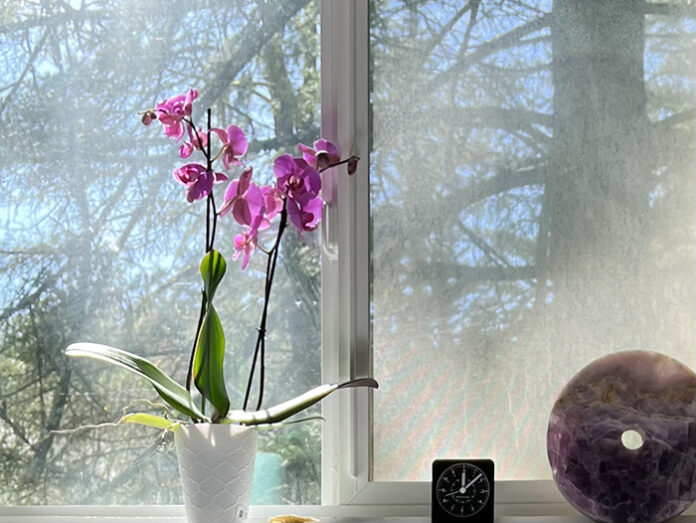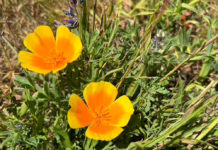
Over the last month, Sonoma hasn’t experienced the sunshine that Californians are used to.
With day after day of rain, it was especially uplifting to look out the window to sun beams backlighting this orchid, turning petals translucent purples and leaves light and dark contrasts in green. Even the rock sculpture turned translucent purple, harmonizing with its orchid neighbor.
This week also marked Daylight Saving Time. Love the term. Excellent promotional tag—connoting saving time. Would that it were.
Fun facts: The orchid pictured is a Cymbidium. They prefer bright but cool light. Temperatures should not exceed 75° F; evening temps at 50° F encourage blooms.
Flower spikes last about eight weeks. Cutting stems down to the base after bloom helps flowering next year. Regular feeding, once a week, at quarter strength is recommended. Excellent drainage is essential. Ice cubes are a handy trick for measured, slow-release watering.
The rock pictured is Chinese fluorite. Fluorite comes in a variety of colors and colorless. The mineral is also known as fluorspar, or CaF2, and is the state mineral of Illinois.
Fluorine in these rocks can be used in toothpaste and drinking water. In mineral form, the fluorine is inert and therefore not toxic. Fluorite reduces the melting temperatures of metals. Other uses reportedly include non-stick coatings, herbicides, rocket fuel and plastics.
Daylight Saving Time first appeared in 1918 under the Standard Time Act of World War I. Enacted as a temporary seven-month measure, its purpose was to conserve energy.
During World War II, President Franklin D. Roosevelt instituted Daylight Saving Time year-round. Also known as “War Time,” it lasted from 1942 to 1945.
After 1945, states and cities were free to observe Daylight Saving Time or not. Confusion ensued.
In 1966, the Uniform Time Act created a unified observance. That act has been amended several times. Most recently it was amended under the Energy Policy Act of 2005, effective in 2007, where observance is from the second Sunday in March to the first Sunday in November, beginning at 2am each Sunday. As the saying goes, “Spring ahead; fall behind.”
“Would that it were” is an archaic and idiomatic expression where “would” is not the past tense of “will” but an expression denoting a wish without necessitating a subject in the sentence.








